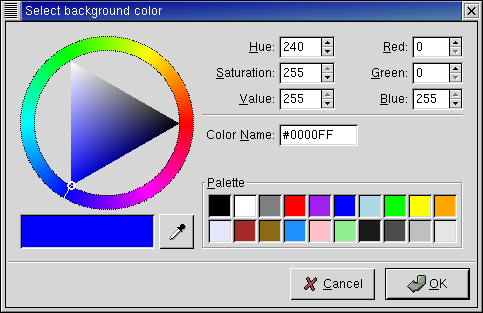Tutorial |
||
 |
||
|
|
||
|
Tutorial |
||
 |
||
|
|
||
|
| ColorSelection(); |
| ColorSelectionDialog(); explicit ColorSelectionDialog(const String& title); |
| Gtk::Button* ok_button()
const; Gtk::Button* cancel_button() const; Gtk::Button* help_button() const; |
| void
set_has_opacity_control(bool has_opacity); |
| void
set_current_color(const Gdk::Color&
color); void set_current_alpha(unsigned short alpha); |
| Gdk::Color
get_current_color() const; unsigned short get_current_alpha() const; |

| #include<inti/main.h> #include <inti/gtk/window.h> #include <inti/gtk/colorselection.h> #include <inti/gtk/drawingarea.h> #include <inti/gdk/color.h> using namespace Inti; class ColorSelectionWindow : public Gtk::Window { Gdk::Color color; Gtk::DrawingArea *area; protected: bool on_drawing_area_event(GdkEvent *event); void on_color_changed(Gtk::ColorSelection *colorsel); public: ColorSelectionWindow(); virtual ~ColorSelectionWindow(); }; |
| #include"colorselection.h" #include <inti/bind.h> ColorSelectionWindow::ColorSelectionWindow() { set_title("Color selection test"); // Create drawing area area= new Gtk::DrawingArea(250, 200); // Set the initial background color and events to receive color.set(0, 0, 65535); area->modify_bg(Gtk::STATE_NORMAL, color); area->set_events(Gdk::BUTTON_PRESS_MASK); area->sig_event().connect(slot(this, &ColorSelectionWindow::on_drawing_area_event)); // Add drawing area to main window add(*area); area->show(); show(); } ColorSelectionWindow::~ColorSelectionWindow() { } bool ColorSelectionWindow::on_drawing_area_event(GdkEvent *event) { bool handled = false; if (event->type == GDK_BUTTON_PRESS) { handled = true; Gtk::ColorSelectionDialog *dialog = new Gtk::ColorSelectionDialog("Select background color"); Gtk::ColorSelection *colorsel = dialog->colorsel(); colorsel->set_previous_color(color); colorsel->set_current_color(color); colorsel->set_has_palette(true); // Connect to the "color_changed" signal colorsel->sig_color_changed().connect(bind(slot(this, &ColorSelectionWindow::on_color_changed), colorsel)); // Show the dialog if (dialog->run() == Gtk::RESPONSE_OK) color = colorsel->get_current_color(); else area->modify_bg(Gtk::STATE_NORMAL, color); dialog->dispose(); } return handled; } void ColorSelectionWindow::on_color_changed(Gtk::ColorSelection *colorsel) { Gdk::Color new_color = colorsel->get_current_color(); area->modify_bg(Gtk::STATE_NORMAL, new_color); } int main (int argc, char *argv[]) { using namespace Main; init(&argc, &argv); ColorSelectionWindow window; window.sig_destroy().connect(slot(&Inti::Main::quit)); run(); return 0; } |
|
|
|||
|
|||